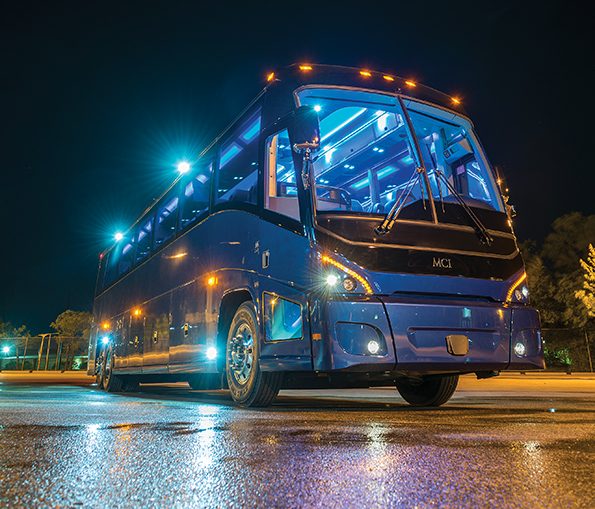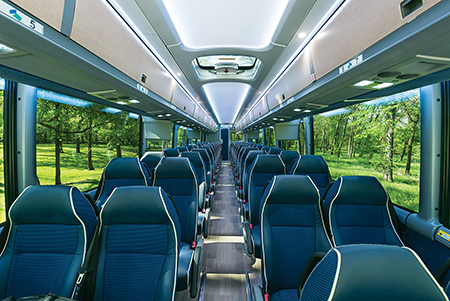
Featuring all-new space and aesthetic considerations, MCI’s newest vehicle means exciting changes for operators and passengers
In 2015, New Flyer Industries’ acquisition of Motor Coach Industries (MCI), triggered ambitious projects throughout the largest motor coach builder in North America, including landmark efforts by the MCI design and engineering team and BMW Designworks USA to optimize the interior of the J4500, MCI’s flagship vehicle.
Now, MCI’s 2018 J4500 is ready for its grand debut.
According to Brent Maitland, MCI vice president of marketing and product planning, MCI’s new mission is big, impactful projects intended to instantly resonate with the dynamic motor coach market and future MCI customers. Based off key feedback from current and prospective MCI buyers, the MCI team centered their attention on interior space maximization and ambiance for the industry’s best-selling coach.
Competitive analysis showed the J4500 already had near best-in-class usable floor space. However, to accommodate 60 passengers with ample legroom to meet MCI’s standards (a minimum of 28 inches, hip to knee), MCI’s design engineers looked for a new approach.

“We knew we wanted to maximize the interior space of the coach, because leg room is such a premium passenger comfort, and it’s also a revenue-generating opportunity,” Maitland says. “At the same time, we wanted to update the J4500’s interior in terms of appearance and lighting.”
So, MCI launched two J4500 projects to improve the interior of
the vehicle:
• Interior Space Maximization Project: With a goal to improve revenue-generating cabin space, the MCI team worked to increase usable floor space to allow for 60-passenger seating configurations, and for more even curbside and roadside seat spacing based on a 56-passenger layout.
• Interior Enhancement Project: The J4500 was already a beloved vehicle in terms of passenger comfort and appeal, but the team sought to do more with the 2018 model. The result was a significant upgrade to seating, trim and lighting that would allow for striking product differentiation for tour and charter operators. There was another desired audience, too — drivers. MCI streamlined the stand-alone systems in the driver’s cockpit to provide a more, attractive, intuitive and functional environment.

The quest for space
The Interior space maximization project began in an unconventional location — at the back of the coach, specifically the lavatory and the nearby air-filtration system.
MCI’s designers and engineers reset the layout of these two features with significant benefits. The new roomier lavatory setup offers easier access. The more efficient compact air-filtration system also creates an even quieter ride.
The J4500’s air filter previously sat at shoulder height between the lavatory and the rearmost seat. Ducting ran from above the roadside transom window across the top of the vehicle and down into the air filter. The team redesigned this entire layout, moving the air intake duct down 4.5 feet, to just above the belt line of the coach. This space-saving approach allowed the team to reorient the lavatory, and slide the last row of seats rearward by 20 inches.
“That leads to a better utilization of floor space that we’re going to be able to bring out to the customers,” Maitland says. “They’ll either be able to use that for improved leg room with more seats or galley space that they can promote. That can add up to significant revenue for operators looking to attract more passengers.”

The new, simplified air intake system and filter has another benefit —lower air restriction than its previous design, therefore providing better engine performance. The new Optair hybrid filter system from Cummins includes a standard centrifugal pre-cleaner to remove dust and water, defining a new standard in engine air intake cleanliness. Lowering the intake grill also results in an even quieter interior and a significantly better utilization of interior passenger revenue-generating space.
This reconfiguration created the opportunity to redesign the J4500’s lavatory, increasing volume by 22 percent and floor space by 28 percent. These positive changes to the lavatory and air-filtration system enabled a spacious new floor layout for the rest of the cabin, increasing curbside hip-to-knee room by over 1-inch per seat and thereby allowing for comfortable, 60-passenger seating.
The new J4500 interior design now features at least 15 inches more usable floor space than its closest competing models, Maitland says. Add that to the latest thin-back passenger seats from Kiel North America or AMAYA-ASTRON, provide at least a half-inch of legroom more than the vehicle’s closest competitors.
One more positive enhancement to the 2018 J4500 emerged from the lavatory and air-intake redesign. Passengers seated in the last two back seats will now have substantially better view. Moving the air-intake vent allowed for a 500 percent increase in the transom window size, as well as an option for a first ever rear window for an MCI J4500 coach.
“The rear window is going to be a welcome aesthetic for certain operators,” Maitland says. “Because of other changes made to the structure, we were able to incorporate this optional feature and improve the passenger experience.”
Luke Busskohl, chief operating officer of Arrow Stage Lines, Omaha, NE, runs a mixed fleet where the majority of his vehicles are MCI. Arrow’s fleet of over 250 motor coaches operates in 13 locations nationwide, and he thinks the new 2018 J4500’s introduction of rear window is a very big deal.
“When riders get on the coach, they immediately notice the openness generated by the windows and lighting,” Busskohl says. “It’s a great new feature which adds quite a bit of visibility and space to the interior.”
Better looks, better profitability
Moving to the rest of the interior, MCI worked with longtime partner BMW Designworks, to create a cabin aesthetic to match the 2018 J4500’s more roomy, comfortable layout. Passengers were the primary focus, but the team wanted to do something for drivers, too.
After all, quality equipment can help attract and retain quality drivers, which play a vital role in passenger safety
and satisfaction.
For the interior enhancements, the 2018 J4500 offers three specifications:
MCI’s Preferred Spec, the well-equipped stock unit; MCI’s High-Spec, which includes pre-determined option package upgrades for trim, seating and lighting; and Customer Spec, where customers can tailor the coach to suit their needs. These trim levels all have color-coordinated interior themes, and MCI will still give buyers their preferred fabrics, with Amaya A-220, GT or Kiel 2050 seating.
“Because branding is so critical, we are always sure to allow customers to choose for themselves, whether it’s for fabrics, trims or interior lighting,” Maitland says. “We’re finding that operators like easy solutions to customize a coach for their various customers. Increasingly, that’s a really important aspect of an operator’s purchasing decision.”
MCI’s 2018 design team went beyond color and comfort to create a sleek, new interior appearance inspired by the airline industry. Indirect LED ceiling lights and spotlights are now standard to create a modern lighting atmosphere for passengers. This indirect lighting — combined with the new rear window space — opens the cabin even more. Storage also got a makeover. Parcel racks now have an improved latch design and new door and surface-finish options to match specific customer design expectations. The parcel racks are now integrated with the J4500’s front interior cap for a cleaner look. Even the windshield blinds, crucial for daytime driving, have been redesigned with a new scissor style mechanism that allows them to recess into the front cap, eliminating exposed guide rods and improving the panoramic views for passengers.
But what passengers will notice the most are the striking enhancements to MCI’s trademark spiral stairway. As pictured, MCI improved stepwell visibility with right and left entryway white lighting and, as a high-spec option, added RGB (red, blue and green) lamps that can be programed to light up the stepwell and the cabin in a color to suit the customer and are coordinated with the cabin lighting. The result is a dramatic entry to the coach.
Using these colors or combinations thereof, operators can choose between red, green, blue, yellow, magenta, cyan and white lighting in the entryway and passenger cabin. All lighting throughout the coach is dimmable, and MCI can still accommodate customized colors through programming. A much-appreciated feature is the “Clean” button, which illuminates all interior lighting to the brightest setting to facilitate coach cleaning.
On the entryway itself, for the High-Spec trim level, MCI added handrail lighting, right- and left-entryway lighting and step-tread lighting based on the RGB color scheme available throughout the coach, from entry to interior.
Terry Fischer, president of Transportation Charter Services (TCS), Orange, CA, says customizable lighting has become a very attractive feature and a significant factor in his vehicle decision-making. “
We’re big on customizing our interiors and customizing the coach to suit our brand,” Fischer says. “On previous models, we worked with MCI to customize the vehicle lighting to suit our colors and branding. With the customizable lighting now available on higher specs, it’s quite a ‘wow’ factor. I haven’t seen any of the other manufacturers doing anything like this.”
Finishing touches
Trim and flooring selections are available in wood-grained and carbon fiber that nicely accompany well-appointed packages named Blues, Lounge and Tech, each which their own attractive colorway. Likewise, visually striking surface options for the parcel rack doors offer a modern matte finish which hides fingerprints.
Additional standalone options on the 2018 J4500 besides the aforementioned new rear window include an entrance-area LED “puddle light” with customizable logo and a tempered glass roof hatch. White LED step nose lighting, window lighting and entrance-area handrail lighting can also be added to a preferred spec coach. Customers may continue to select MCI approved seat models, fabric, flooring and sublimated panels outside of the new interior color theme and Preferred/High-Spec packages.
As for the drivers, MCI has introduced an updated driver’s dash with a new, integrated instrument panel for reduced driver distraction. It features a high-definition, 12-inch Thin-Film-Transistor (TFT) LCD instrument panel from Continental and A/V and HVAC displays from REI. The new cockpit also has improved visibility over the dash hood, increased driver legroom and a toe kick.
Maitland says that, together, the new dash and entryway have best-in-class functionality, ergonomics and aesthetics. Drivers will know this cockpit was designed around them.
Orders are open
MCI began its first customer showings in June, and plans on making its first customer sales demos available by August. Peter Pan Bus Lines, Springfield, MA, runs an MCI-exclusive fleet of 250 motor coaches in the Northeastern U.S., and its company leadership was very impressed by the new 2018 J4500 layout redesign.
“We tested every different seat model MCI offers, and we were able to check the legroom out in all instances. We’ve chosen to go with the increased capacity, moving from 54 to 56 passengers,” says Peter Picknelly, chairman and CEO of Peter Pan Bus Lines. “It adds two passengers to what we normally buy, and still provides added legroom. That’s two more seats in our business but, for the life of the coach, that’s a significant amount of revenue.”
Tom Picknally, senior vice-president of maintenance at Peter Pan, adds that the Peter Pan team was blown-away by how much customers will notice the changes to the vehicle.
“We like it a lot,” he says. “We came away, after seeing the new coach, really keyed in on the customer-facing appeal this new vehicle has.”
Despite the dramatic upgrades, Maitland says that MCI was careful about changing anything drastically. The new J4500, he says, fits in perfectly with the MCI family of motor coaches.
“From design to development, our engineers focused hard on evolving the J4500, while not outdating previous models,” he says. “We want there to still be a lot of familiarity for J4500 owners and their customers. That’s very important to us.”
Credit goes to the MCI design and engineering team that worked hard to make these changes fit in nicely with previous J4500 models, while still creating a model that’s ahead of its time in so many ways.
